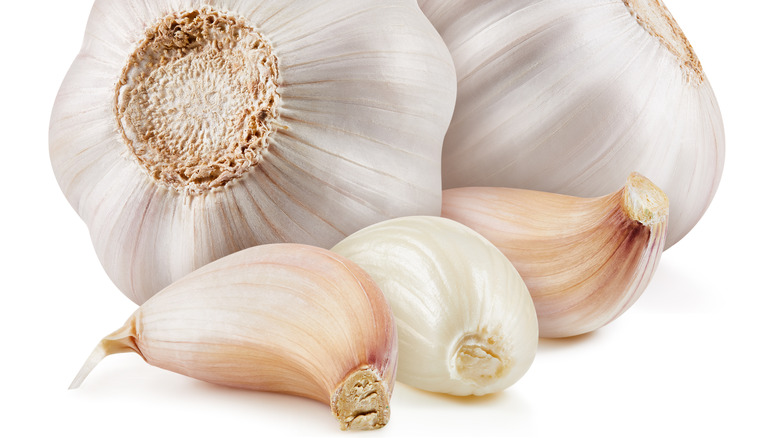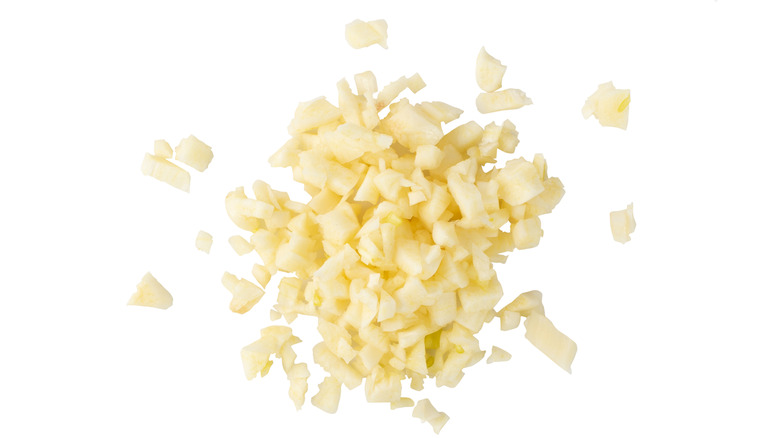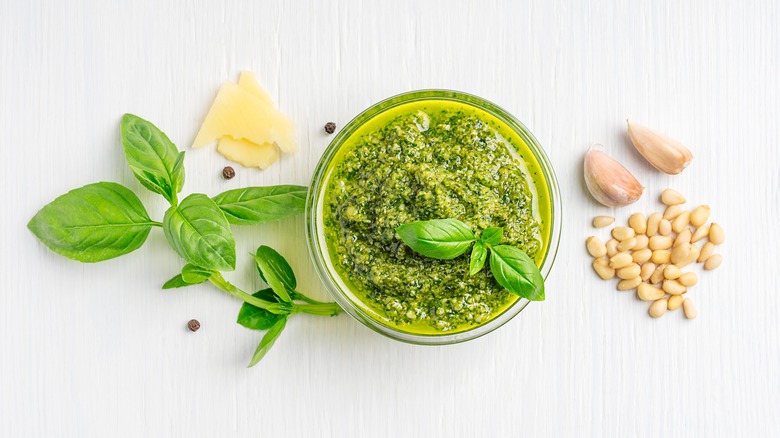The Scientific Reason Garlic Tastes Milder After Rinsing It
Garlic is essential to countless recipes; Italian cooking would cease to exist without it. (What would spaghetti and meatballs be without garlic?) Shrimp scampi wouldn't exist. And no garlic bread? Unthinkable. But using garlic can be tricky. You can't just add it raw to dishes, unless you want permanent garlic breath.
Garlic is a member of the allium family, explains Wisconsin Horticulture, along with onions, chives, leeks, scallions, and shallots. These vegetables contain fragrant, pungent chemicals called organosulfur compounds, which include allicin, diallyl sulfide, and diallyl trisulfide, among others. Did you notice the word "sulfide" in those names? Yes, when you cut into an onion, the fumes react with the water in your eyes to make sulfuric acid, per PBS. Ouch.
But those same compounds, when tamed, are part of the allium family's charm. And there are two ways to tame them when you're working with garlic: cooking and rinsing.
Rinse away the harshness
Until garlic is cut or chopped or minced, the compounds stay inside the cloves. It's only when you cut into the cloves and expose them to air that the enzymes in the cloves start working. If you want to use raw garlic but want to mellow the flavor, you can reduce the pungency another way: rinse the chopped garlic. Rinsing garlic will remove the allicin and the allinase on the surface of the garlic, reducing the harsh flavors.
The compound that gives garlic its sharp mustardy bite is called allicin. That molecule contains sulfur. And it's related to the compound that makes wasabi so strong, per The New York Times. The allicin sends a signal to your brain that fire is on the way, and it registers as pain.
According to Oregon State, when the cloves are cut or crushed, an enzyme called allinase breaks down allicin, making many sulfur-like compounds that are pungent and strong. The more the garlic is crushed, the more compounds are formed. Cooking denatures (deactivates) the enzyme, per America's Test Kitchen, which stops the formation of these molecules, so the flavor becomes mellow. In addition, as the cloves cook, the sugar and carbs in the garlic break down into smaller molecules which are sweeter.
Use your rinsed garlic
To rinse the garlic, just place the chopped or minced pieces in a fine strainer. Run it under cool water, shake off the excess, and use it in your recipes.
How are you going to use your milder garlic? You can stir the raw garlic into a vinaigrette or make a delicious aioli (a fancy word for mayonnaise). Blend some tamed garlic into homemade lemon basil pesto or creamy homemade hummus. Your tamed garlic will be delicious in Lynda Carter's Caesar salad. Or try a new type of recipe: honey-pear pizza or a garlic maple dressing.
You should also know that garlic is very good for you. BBC Good Food states that garlic may reduce the risk of a heart attack and may have anti-carcinogenic properties. Garlic also fights infection. And because raw, rinsed garlic has more allicin than cooked garlic, you're ahead of the game.


